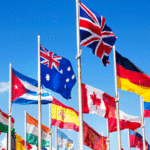Last summer we saw some amazing athletes strutting their stuff - But as the world’s nations start to think about the next Olympic Games in 2024 Paris, we’re already starting to see excited spectators around the world gearing up with all kinds of flags from different countries. At The Flag Shop, we can’t help but love it–almost, dare we say, as much as we love the Parade of Nations!
Over here, we’ve got our Giant Union Jack and World Flags ready for the Opening Ceremony. As we decorate and hedge our bets on which athletes might nab a gold, we’ve also been sharing a few little known facts about some of our favourite flags.
Here’s what you probably didn’t know (and may have a hard time believing!) about a few of the world’s most iconic flags…
The Union Jack
Most Britons know that the Union Jack is a combination of several separate standards: the St George’s Cross Flag of England, white St Andrew’s Saltire of Scotland, and red St Patrick’s Saltire of Ireland. But while it was officially adopted in 1801 as the flag of the United Kingdom, did you know that the current design dates back to 1606, when King James I inherited both the English and Irish thrones, as well as being monarch of Scotland?
Or, that the flag we know and love today wasn’t officially known as the ‘Union Jack’ until long after that time? The exact origins of the exact term ‘Union Jack’ are still unclear, but it’s widely agreed that ‘Jack’ stems from the standard’s regularly being flown on a ‘jackstaff’ on the bow of all British ships. As we’re seeing lots more of the Union Jack during Her Majesty’s Platinum Jubilee year, there’s a little fact you can share with your colleagues!
The ‘Stars and Stripes’
Anyone can pick the U.S.A flag out of a lineup, but could you say for sure how many stripes and stars it features? Save your Millionaire lifelines: the official United States Flag has 13 stripes and 15 white stars in total. Each stripe on ‘Old Glory,’ as it’s referred to, represents the original 13 colonies that joined the Union as states, while each of the 50 stars signifies one of those states. The star-spangled banner itself has gone through a total of 28 different designs since it was adopted as the national flag on July 4th, 1960.
Now here’s something you definitely didn’t know: five American Flags have made it to the moon. No risk of strong winds there!
Flag of Nepal
Not all flags are squares or rectangles–the official Nepalese flag is what’s referred to as a double-pennon, which has the look of two triangles, one above the other. But why?
Turns out, the two triangles represent the Himalayas, as well as Buddhism and Hinduism, the country’s two dominant religions. The different colours on this spectacular pennant are also significant: red represents the country’s national flower (the rhododendron), as well as the Nepalese citizens’ bravery, while blue signifies peace and harmony, both of which are central to Buddhism. Finally, the sun and moon on the Nepal flag denote permanence, a desire for the country to last as long as these celestial bodies.
The Nisshoki/Hinomaru
Did you know that the official flag of Japan goes by two other names? Celestial bodies are popular features of national flags, and this flag is no exception–the crimson circle in the centre of this standard represents the sun. While the exact origins of the Japan Flag can’t be pinned down exactly, it is believed that they date back to the period of Japan’s history called the Warring States/Sengoku Period, somewhere between 1467 and 1615 when the country was in a constant state of upheaval.
Two iterations of the Japanese Flag are commonly seen. Apart from the standard white background and a red sun, the Hinomaru can also feature rays emanating from the sun itself, which is why it is sometimes known as the Rising Sun Flag.
Flag of Wales
The Wales Flag is another head-turner that dates back to 1959. But what can you tell us about the iconic red dragon? It seems that the mythical beast has represented Wales since as far back as 830, in a Historia Brittonum text describing the struggle between two underground serpents and King Vortigern. This flag is steeped in tradition, having been described as King Arthur’s battle standard and a story of two battling dragons: white for the Saxons and red for the Britons. It’s said that Merlin himself prophesied the red dragon’s victory during the conflict of the 5th and 6th centuries, and the fearsome beast features throughout popular poetry of the time.
While we could go on about our favourite flags, we’ll save the rest for another time. Now that you’ve got something fun to share with your friends as you go about your upcoming celebrations, you’re probably as excited as us!















